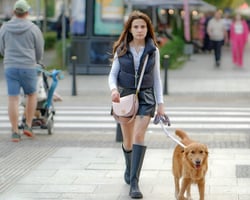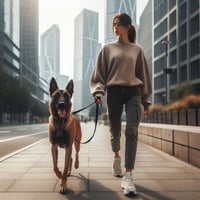Discover essential safety tips and guidelines for being a responsible dog walker when walking other...
Empowering Urban Dog Owners: Defensive Maneuvers for Rescued Large Dog Breeds
Bringing a recently rescued large dog breed into an urban setting can be an exciting yet challenging experience. These dogs may have a history of abuse, neglect, or unknown triggers that can result in defensive behaviors. As a responsible owner, it's important to equip yourself with defensive maneuvers to ensure the safety of both your dog and those around you. In this article, we will explore effective techniques and practical examples of defensive maneuvers to help you navigate urban environments with your newly rescued large dog breed.
Recognizing Defensive Behaviors:
- It's crucial to identify and understand the signs of defensive behaviors in your dog. These may include growling, baring teeth, lunging, raised hackles, or freezing. By recognizing these warning signs, you can take proactive measures to prevent escalation and maintain control of the situation.
Implementing Distance and Space Management:
- One of the key defensive maneuvers is managing distance and space. When encountering potential triggers, such as crowded streets or unfamiliar people, maintain a safe distance to prevent your dog from feeling overwhelmed. Use physical barriers, such as crossing the street or moving to the side, to create space between your dog and potential triggers.
Utilizing Focus and Redirect Techniques:
- Training your dog to focus on you and redirect their attention is an effective way to redirect defensive behaviors. Teach your dog commands like "watch me" or "leave it" to redirect their focus onto you and away from potential triggers. Engage them in obedience exercises or interactive games to keep their attention on you and reinforce positive behavior.
Incorporating Desensitization and Counterconditioning:
- Gradual exposure to the urban environment and potential triggers can help desensitize your dog to stressful situations. Start by exposing them to low-intensity stimuli and gradually increase the difficulty level. Pair these exposures with positive experiences, rewards, and praise to create positive associations and countercondition their responses.
Using Proper Leash Handling Techniques:
- Proper leash handling is essential when managing a large dog breed in an urban setting. Ensure you have a sturdy leash and a comfortable, secure harness or collar. Use a leash with appropriate length to maintain control while allowing your dog some freedom to move. Practice loose leash walking techniques to maintain calm and prevent reactive behaviors.
Seeking Professional Guidance:
- If you're dealing with a recently rescued large dog breed with defensive behaviors, seeking professional guidance is highly recommended. A qualified dog trainer or behaviorist can assess your dog's specific needs, provide personalized training plans, and guide you through the process of managing defensive behaviors in an urban setting. Their expertise will help you build a strong foundation of trust, communication, and obedience.
Example Scenario:
Imagine walking your recently rescued large dog, Max, in a busy urban park. As you approach a crowded area, Max starts displaying defensive behaviors, such as raised hackles and growling. Employing defensive maneuvers, you quickly assess the situation and create distance by veering to the side. You engage Max with a focus command, redirecting his attention back to you. By maintaining control and implementing the techniques you've learned, Max remains calm, and the potential escalation is prevented.
Conclusion:
Navigating an urban setting with a recently rescued large dog breed requires a proactive approach and effective defensive maneuvers. By recognizing defensive behaviors, implementing distance and space management, utilizing focus and redirect techniques, incorporating desensitization and counterconditioning, and practicing proper leash handling, you can create a safe and positive environment for your dog. Remember, seeking professional guidance is essential to address any underlying behavior issues and ensure the most effective training methods. With patience, consistency, and the right techniques, you can empower yourself as an urban dog owner and provide your recently rescued large dog breed with the support and care they need to thrive.
.png?width=50&height=50&name=Profile%20round%20logo%20(1).png)


